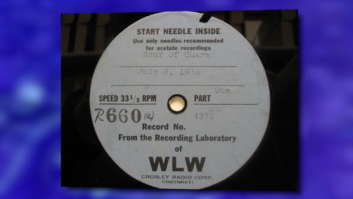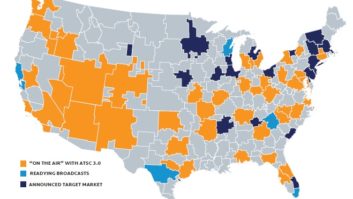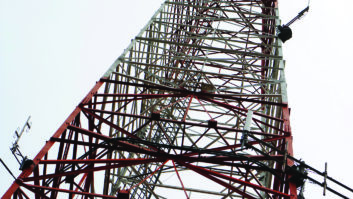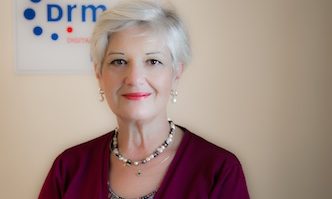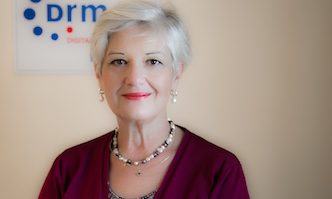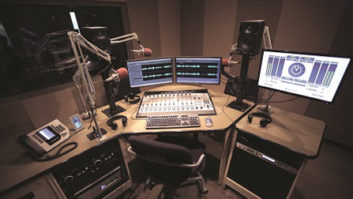Contemplating the Future
Dec 1, 2003 12:00 PM, By Kari Taylor, associate editor

Take a moment and think back to 1994. What was the life of a radio engineer like in 1994? Most radio stations still used cart machines. Operator permits were still required by the FCC. Now, think about the next 10 years of radio. What will the radio industry be like in 2014? Will machines be so intelligent that they can fix themselves when they break? Will digital radio be the standard way of broadcasting and analog radio will be a vague memory for engineers to reminisce about? Will satellite radio take over the world?
To gain some insight, I consulted several radio industry professionals. Our discussions about technological advances in the next 10 years provided some interesting ideas and plans for the future.
�I think by the time we get 10 years out there, digital radio will be solidly established, and I might even make the prediction that the majority of listening will be done digitally by that time,� said Milford Smith, vice president of engineering at Greater Media in East Brunswick, NJ. �Most of the issues have been ironed out with digital radio and we’re actually seeing a fair amount of stations going on the air � more all the time.�
�But I also think along with that is an opportunity that we’re really just starting to recognize and starting to pursue, and that is the opportunity for data services, either associated with the main program material, or perhaps not associated with it at all. The ability of a broadcaster to offer sort of a multimedia experience really hasn’t been possible up until the advent of digital radio, so I think there is going to be tremendous growth in that area over the next 10 years,� Smith said.
When asked about technological advances in the next 10 years, Dave Maxson, who is a managing partner of Broadcast Signal Lab in Boston, believes that every new radio will be digital. �Even if it’s only picking up an analog signal � that is, the technology for extracting the most out of analog signals are improving with digitally-based chip sets,� Maxson said.
Maxson agrees with Smith that the technical kinks of IBOC operation have mostly been resolved, and that the overall listener experience of radio will be greatly improved with digital radio. Maxson said he would tell IBOC skeptics that technical compromises have been made that the NRSC sees as offering a substantial improvement in service.
�We’re all used to fiddling with our antennas in order to get rid of the multipath in FM reception. We’re used to having cheap $10 radios that pick up six stations when there are 30 or 40 available. We’re used to AM interference and AM fades under bridges and structures. IBOC makes that pretty much go away. So, there are advantages to digital radios that pick up IBOC over digital radios that will make the best of analog they possibly can,� Maxson said.
Maxson also pointed out an important advantage to IBOC: the opportunity to enhance the listener experience with multimedia and interactive features. �It’s not TV for radio,� Maxson said. �It’s the ability to provide text and images that can be stored and manipulated along with the audio, and that will create a richer experience for the radio listener. And, the nay-sayers will say �You can’t mess with that in your car, you’re busy driving.� To a degree that’s true. On the other hand, with a couple of simple feature buttons on a digital radio with these new capabilities, the radio will even be able to provide people driving a car with a more useful service.�

�There’s discussion about location-based technology so that your car knows where it is and digital radio is receiving information all the time. For example, you can find the location of the nearest fast food joint at the touch of a button. Or perhaps the nearest fast food joint that is carrying a promotion that the radio station that you’re tuned to is offering. Another example would be the ability to pull up a location-based traffic report in the voice of your favorite radio host or things like that, that will enhance your driving experience while keeping you in tune with your favorite radio station. You don’t have to wait for traffic on the 3s or 9s or whatever it is that the local traffic station does. You would be able to get it much more immediately, in a familiar voice and for your location,� said Maxson.
�These are just simplistic examples from the point of view of what possibilities an interactive radio can offer. The reality is that we don’t know which one of these applications is going to stick and be useful to consumers and be cost efficient for broadcasters until we try them.�
When asked for his thoughts on digital radio, Chief Engineer Gordon Carter of WFMT in Chicago didn’t completely agree with Smith and Maxson. �I think in 10 years they will figure out how to make it work right, but getting it right may be very painful,� said Carter. �I think that the current system, while it has a lot of potential, still has a lot of bugs that need to be worked out. But I think they will get there.�
�On the other hand, between now and then, who knows what will come along that will be newer and better,� Carter said. �From what I’ve seen, most of the technologies we’re working with are less than 10 years old now. I think that’s something that we have to be alert to. Technology does change and there is very likely something, or some way that nobody has figured out yet that will make everything we’re doing with IBOC right now obsolete.�
John Marino, vice-president of science and technology for the National Association of Broadcasters in Washington, DC, believes the digital broadcasting technologies will offer new flexibility for broadcasters. �Data services will usher in a new wave of multimedia radios complete with graphic displays. These new digital radios will offer broadcasters an opportunity to send a variety of information directly to listeners. Such information may include song title and artist, traffic information, emergency warnings, news, weather and other customized data and graphics,� said Marino. �The often joked-about radio station in a suitcase may be right around the corner.�
According to these professionals, IBOC will become the standard in radio eventually. However, I got the impression that the industry needs to be on the lookout for new technologies that will surpass IBOC in usefulness and clarity in the next 10 years.
Continued consolidation?
My next question for the group dealt with consolidation. Is it over? Is there more to come? If so, where will it happen?
�Radio in the larger and even medium markets is largely consolidated now,� Smith said. �I think that consolidation is already seeping down to the very smallest markets. I think that’s probably going to continue. It seems like most of the shouting is over. There will probably be some of the smaller groups that ultimately get swallowed up by some of the larger groups, but I think the majority of the activity in that area, other than in the smallest markets, has already transpired.�
Contrary to some radio industry professional’s opinion, Maxson doesn’t agree that consolidation of ownership has reduced the number of radio choices. �Ownership isn’t ruining radio. My experience is from being here in Boston, and Boston really never had a country station until there was consolidation. Boston has seen some experiments with different kinds of formats. For example, when the fourth or fifth station of a group that has always had moribund ratings and is looking for a new way to do things. A group owner can take more of a risk with that station and try a new format.�
�Radio attempts to appeal to a large enough audience to make it economically viable. Radio is about reaching a target audience with what they want to hear. And that has implications into how you program a station and how you energize your audience. Those basic precepts of radio are not going to change.�
�While there is consolidation in the major radio stations, there is also this tremendous clamoring that’s been going on for a couple of decades for specialized, local outlets for programming. I think we will see further loosening of the spectrum for these small bands of radio freedom fighters who want to broadcast something that, in their perception, is in the community interest. There will be ways for these low-power stations to proliferate without affecting the economic base of the industry,� said Maxson.
While Smith believes most of the consolidation activities have already taken place in the large markets and is now seeping into the smaller markets, Carter believes that the radio industry will see its continuation and that it will remain mostly in the larger markets. �It becomes a matter of money,� Carter said. �They’re going where the money is, or where they perceive the money is. I think we’re going to see the consolidation being played at a slightly lower level, where the medium-market groups are going to start making a move for a bigger share of the pie.�
�I also think we’re going to see a resurgence of the ma and pa stations, especially in the small markets,� Carter said. �Where the big groups just don’t have the incentive to put the money in because they can’t take the money out. I hope it happens because I think that’s what makes radio exciting � the localism of it. That’s something that even our friends at Clear Channel will say they can’t provide that well.�
After listening to these opinions, it’s clear that consolidation has several potential paths to take. One person thinks it’s almost over, while another thinks there there’s still a lot of consolidation to be done. One person thinks local radio is dying because of consolidation and another thinks consolidation makes radio more diverse. My head was spinning.
Personally, I believe consolidation will continue throughout the next 10 years, however it won’t happen with such fervor. I also believe that local radio stations will never go away. There may be fewer of them in time, but in the end, if that’s what people want, that’s what they will get.
Radio vs. ?
My final question for the group was about competition. Do they think radio will be able to not only compete with other media, but also continue to be the leader in audio entertainment in the next 10 years?
�I think satellite is starting to get its pace a little bit,� said Carter. �I don’t know if economically the companies can hold out long enough to really get established in their niche the way they need to be. But, for instance, I just saw an ad on TV for XM radio that is modular so it can be plugged into your car or taken into your house and plugged into a receiver there or an appliance. I think that’s the sort of thing it needs.�
�I think it would really make a lot of sense, though I realize there are several issues involved, if terrestrial [and satellite] digital radio could all use the same decoder. And I think we need to see better cooperation with the various proponents. It would make sense to me to see that sort of convergence.�
Carter continued, �You see it happening now with TV where you’re using the same box to look at TV and your computer and all kinds of other things. Whether it will happen or not, I don’t know. It’s hard to tell because there are so many special interests groups involved. I think consumers are going to say � wait a minute, we just bought our satellite digital receiver, now you want me to buy another digital receiver for my radio? I don’t think so.�
Smith agrees with Carter that satellite radio does not appear to be going away. �Even though the listenership is still miniscule compared to commercial over-the-air radio, it’s not zero. It’s growing and that’s something we need to be cognizant of. I think the ability of broadcasters to transfer to a digital platform is going to be a big help there,� said Smith.
�However, the largest threat is not satellite radio and it’s not Internet radio. The competition lies in the ubiquitous roll out of wideband wireless 3G and beyond, where is it possible for any mobile individual or vehicle to have access to a big pipe, in terms of data. And because of the existence of that big pipe, that data can be anything, including audio entertainment. So I’ve always thought that the real threat to radio broadcasting is wireless broadband. I think that has a likelihood of being out there in less than 10 years, but definitely in 10 years it will be well established. It’s obviously going to take whatever form based on what its consumers are looking for, but as I say, one of those forms could look a lot like radio. And that does give me some cause for concern,� Smith said.
After talking with Smith, I was concerned too. I had considered the obvious competition, such as Internet radio and satellite radio, but I hadn’t thought about wideband wireless applications being a formidable competitor for radio listeners. 3G is about connectivity to end users, which could definitely impact radio.
Going nowhere
All in all, from these professional’s responses, it sounds as though there will be some big changes happening within the radio industry during the next 10 years. But no matter what technological advances are made, or how many radio stations a particular company owns, they all believe that radio will still be the dominant audio entertainment medium.
�Radio is still a wonderful medium and it’s a unique medium,� said Smith. �It’s still the only truly portable medium. The satellite people are trying to get their product to that extent, but there are 900 million consumer radios in the country at this point. It can be as small as a walkman and its ubiquitous in virtually every car and every home.�
�There’s no other medium that enjoys that kind of penetration, nor is there any other medium that enjoys the kind of listenership that radio has in an average week,� said Smith. Something like 95 percent or 96 percent of all Americans sten to radio every week. That is pretty impressive stuff. I think the consumer very much wants and needs a portable audio entertainment and information medium, and from what I am seeing so far, radio really is the medium that best fills that requirement.�
�I think there will be some minimal inroads from satellite, and some from wireless broadband depending on what form it takes, but I see radio as still the core primary audio entertainment medium for most Americans through at least the next 10 years.�
I couldn’t have said it better.






